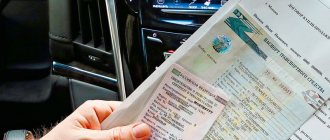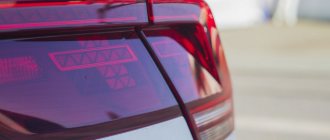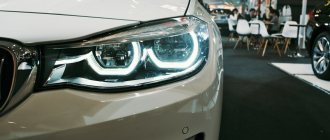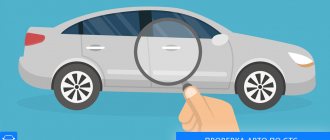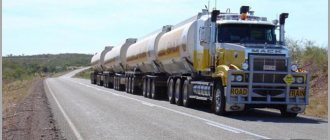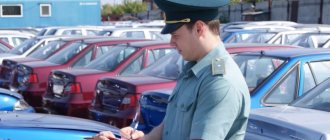Video
What else is worth reading
Warning
Prescriptive
Prohibiting
Information signs
Horizontal markings
Traffic Laws. License plates, identification marks, inscriptions and designations.
30.1
Owners of motor vehicles and trailers for them must register (re-register) them with the authorized body of the Ministry of Internal Affairs or carry out departmental registration if the law establishes the obligation of such registration, regardless of their technical condition, within 10 days from the date of purchase (receipt), customs clearance registration or re-equipment or repair, if it is necessary to make changes to the registration documents.
30.2
On motor vehicles (except for trams and trolleybuses) and trailers, license plates of the appropriate type are installed in the places provided for this purpose, and a self-adhesive radio frequency identification tag is attached to the right upper part of the windshield (on the inside) of the vehicle subject to mandatory technical control. passing mandatory technical control of a vehicle (except for trailers and semi-trailers) (added 01/23/2019)
.
Trams and trolleybuses are marked with registration numbers assigned by the relevant authorized bodies.
It is prohibited to change the size, shape, designation, color and placement of license plates, put additional markings on them or cover them, they must be clean and sufficiently illuminated.
30.3
The following identification marks are installed on the corresponding vehicles:
| a) | “Road train” - three orange lights located horizontally above the front part of the cab (body) with gaps between the lights from 150 to 300 mm - on trucks and wheeled tractors (class 1.4 tons and above) with trailers, as well as on articulated buses and trolleybuses; |
| b) | “Deaf Driver” is a yellow circle with a diameter of 160 mm with three black circles with a diameter of 40 mm inside, located at the corners of an imaginary equilateral triangle, the apex of which is directed downward. The sign is placed on the front and rear of vehicles driven by deaf or deaf-mute drivers; |
| V) | “Children” is a yellow square with a red border and a black image of the symbol of the road sign 1.33 (the side of the square is at least 250 mm, the border is 1/10 of this side). The sign is placed on the front and rear of vehicles transporting organized groups of children; |
| G) | “Long vehicle” - two yellow rectangles measuring 500 x 200 mm. with a red border 40mm high. made of reflective material. The sign is placed on the rear of vehicles (except route vehicles) horizontally (or vertically) and symmetrically relative to the longitudinal axis, the length of which is from 12 to 22 m. |
| Long vehicles, the length of which, with or without cargo, exceeds 22 m, as well as road trains with two or more trailers (regardless of the total length) must have an identification mark placed on the rear (in the shape of a yellow rectangle measuring 1200 x 300 mm with a red border 40mm high) made of reflective material. The sign shows an image of a truck with a trailer in black and indicates their total length in meters; | |
| G) | “Driver with a disability” is a yellow square with a side of 150 mm and a black image of the plate symbol 7.17. The sign is placed on the front and rear of motor vehicles driven by drivers with disabilities or drivers who transport passengers with disabilities; |
| d) | “Dangerous Goods Information Table” is an orange rectangle with a reflective surface and a black border. The dimensions of the sign, the inscriptions of identification numbers of the type of hazard and hazardous substance and its placement on vehicles are determined by the European Agreement concerning the International Carriage of Dangerous Goods by Road; |
| e) | “Danger Sign” is an information table in the shape of a diamond, on which a danger sign is depicted. The image, dimensions and placement of tables on vehicles are determined by the European Agreement concerning the International Carriage of Dangerous Goods by Road; |
| e) | “Column” is a yellow square with a red border, in which the letter “K” is inscribed in black (the side of the square is at least 250 mm, the width of the border is 1/10 of this side). The sign is placed in front and behind vehicles moving in a convoy; |
| and) | “Doctor” is a blue square (side - 140mm) with an inscribed green circle (diameter - 125mm), on which a white cross is applied (stroke length - 90mm, width - 25mm). The sign is placed on the front and rear of vehicles owned by physician drivers (with their consent). If the identification sign “Doctor” is placed on the vehicle, it must have a special first aid kit and instruments according to the list determined by the Ministry of Health to provide qualified assistance in the event of a road traffic accident; |
| h) | “Oversized cargo” - signal boards or flags measuring 400 x 400 mm. with alternating red and white stripes applied diagonally (width - 50 mm), and in the dark and in conditions of poor visibility - reflectors or lights: white in front, red in back, orange on the side. The sign is placed on the outermost parts of the cargo protruding beyond the dimensions of the vehicle by a distance greater than that provided for in paragraph 22.4 of these Rules; |
| And) | “Maximum speed limit” - an image of a road sign 3.29 indicating the permitted speed (sign diameter - at least 160 mm, border width - 1/10 of the diameter). The sign is placed (applied) at the rear left on motor vehicles driven by drivers with up to 2 years of experience, heavy and large vehicles, agricultural machinery whose width exceeds 2.6 m, vehicles carrying dangerous goods by road, when transported by truck passengers' car, as well as in cases where the maximum speed of the vehicle, according to its technical characteristics or special traffic conditions determined by the National Police, is lower than that established in paragraphs 12.6 and 12.7 of these Rules; |
| i) | “Identification car sign of Ukraine” is a white ellipse with a black border and the Latin letters UA printed inside. The length of the ellipse axes should be 175 and 115 mm. Placed at the rear of vehicles in international traffic; |
| i) | |
| "Vehicle identification mark" - a special strip of reflective film with alternating red and white stripes applied at an angle of 45 degrees. The sign is placed on the rear of vehicles horizontally and symmetrically relative to the longitudinal axis as close as possible to the outer dimensions of the vehicle, and on vehicles with a van body - and vertically. On vehicles used for road work, as well as on specially shaped vehicles and their equipment, the sign is also placed on the front and sides. An identification sign must be placed on vehicles that are used for road work, as well as on vehicles that have a special shape. On other vehicles the identification mark is placed at the request of their owners; | |
| j) | “Taxi” - squares of a contrasting color (side - at least 20 mm), which are placed in a checkerboard pattern in two rows. The sign is installed on the roof of vehicles or applied to their side surface. In this case, at least five squares must be applied; |
| To) | “Training vehicle” is a white equilateral triangle with the apex up and a red border, in which the letter “U” is inscribed in black (a side is at least 200 mm, the width of the border is 1/10 of this side). The sign is placed on the front and rear of vehicles used for driving lessons (it is permissible to install a double-sided sign on the roof of a passenger car); |
| l) | “Spikes” is a white equilateral triangle with the apex upward and a red border, in which the letter “Ш” is inscribed in black (the side of the triangle is at least 200 mm, the width of the border is 1/10 of the side). The sign is placed on the rear of vehicles equipped with studded tires. |
30.4
Identification marks are placed at a height of 400-1600mm. from the road surface so that they do not limit visibility and are clearly visible to other road users.
30.5
To indicate a flexible hitch when towing, flags or shields measuring 200x200 mm are used with alternating red and white stripes of reflective material 50 mm wide applied diagonally to them (except for the use of a flexible hitch coated with reflective material).
30.6
| The warning triangle in accordance with GOST 24333-97 is an equilateral triangle made of red reflective strips with an internal red fluorescent insert. |
30.7
It is prohibited to apply on the external surfaces of vehicles images or inscriptions that are not provided by the manufacturer or that coincide with color schemes, identification marks or inscriptions of vehicles of operational and special services, provided for by DSTU 3849-99.
On the body or glass
Stickers are placed on the outside of the vehicle to warn other drivers in traffic of potential hazards. Based on them, motorists adjust the movement of their vehicles.
Student driving
This sticker indicates that the driver of a particular car is a student who is only practicing driving skills under the guidance of an instructor.
Having noticed such a sign inside the traffic flow, other drivers should concentrate as much as possible on the road situation. You should not honk sharply or shorten the distance unjustifiably. It is always better to leave such a car room to maneuver.
Inexperienced driver
Such a motorist behind the wheel is indicated by a yellow square with an exclamation mark in the middle.
This sticker is placed on the rear window of the vehicle, identifying a driver who received his license less than two years ago.
It is allowed to be left until the driver feels confident enough within the traffic flow.
Description of traffic rules signs. Characteristics of traffic signs for drivers of various categories and pedestrians. Preparation for passing exams on the Rules of the Road online, detailed description of road signs and markings. Traffic lessons.
Identification signs or plates serve to limit or clarify the effect of the sign with which they are used.
| Road sign | Name of the sign | Description of the road sign |
| 9.1 . Road train | Truck and tractor with trailer. Articulated bus or trolleybus. Must be installed on the roof of the cab. The lights must be on when driving. In the dark or when visibility is limited, the lights also turn on during stopping and parking (clause 19.8 of the Russian Traffic Regulations). | |
| 9.2 . Spikes | A vehicle with studded tires. Must be installed at the rear of the vehicle. | |
| 9.3 . Transportation of children | Organized transportation of a group of children. Must be installed at the front and rear of the vehicle. | |
| 9.4 . Deaf driver | A vehicle driven by a deaf or deaf-mute driver. Must be installed at the front and rear of the vehicle. | |
| 9.5 . Training vehicle | A vehicle used for driving instruction. It must be installed at the front and rear of the vehicle; installation of a double-sided sign on the roof of a passenger car is allowed. | |
| 9.6 . Speed Limit | A vehicle that carries out organized transportation of groups of children, transporting large, heavy, dangerous goods, or a vehicle that, according to its technical characteristics, is not capable of reaching the maximum speed specified in paragraphs. 10.3, 10.4 Traffic rules of the Russian Federation. Must be installed on the rear left side of the body. | |
| 9.7 . Dangerous goods (international transport) | A vehicle transporting dangerous goods (signs indicate the properties of the dangerous goods). Must be installed in the front and rear, on the sides of vehicles, on the sides of tanks and containers. | |
| 9.8 . Dangerous cargo (other transportation) | A vehicle transporting dangerous goods (signs indicate the properties of the dangerous goods). Must be installed at the front and rear of the vehicle. | |
| 9.9 . Oversized cargo | A vehicle carrying large cargo. It must be installed on protruding parts of the load. | |
| 9.10 . Slow moving vehicle | A vehicle that, according to its technical characteristics, is not capable of reaching speeds above 30 km/h. Must be installed at the rear of the vehicle. | |
| 9.11 . Long vehicle | A vehicle with a length (laden or unladen) of more than 20 m or a road train with two or more trailers. Must be installed at the rear of the vehicle. | |
| 9.12 . Novice driver | A vehicle driven by a driver with less than 2 years of driving experience. Must be installed at the rear of the vehicle (except motorcycles, tractors and self-propelled vehicles). | |
| 9.13 . Doctor | A vehicle driven by a driver-doctor. Installed at the driver's request in front and behind the vehicle. | |
| 9.14 . Disabled person | A vehicle driven by a disabled person of group I or II or transporting such disabled people. Installed at the driver's request in front and behind the vehicle. |

